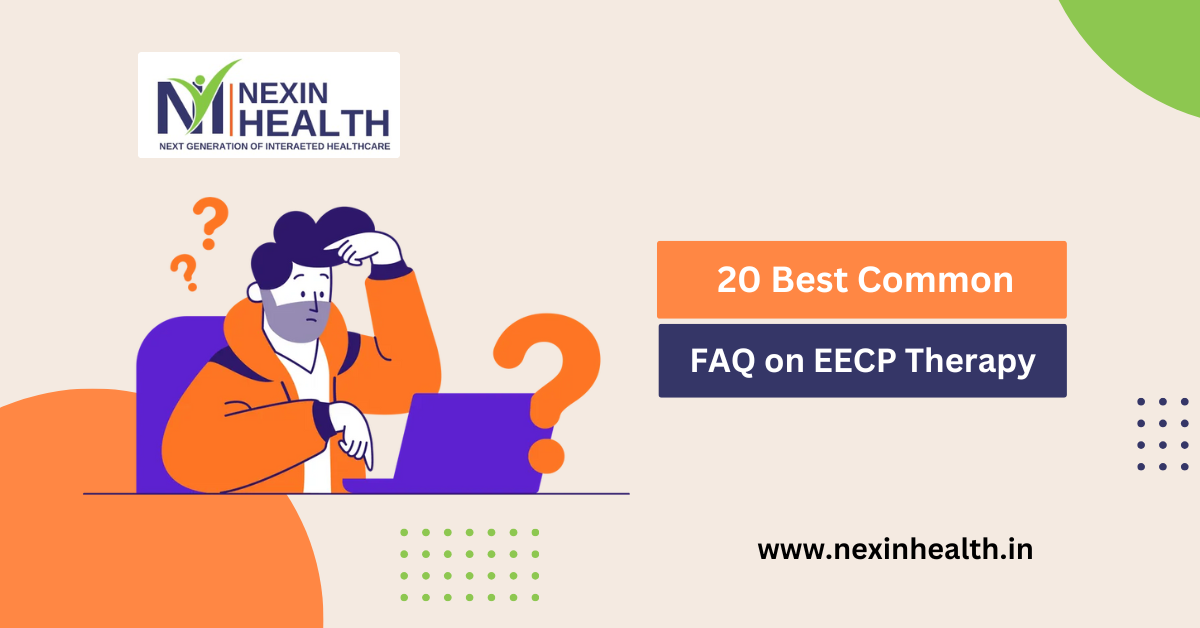20 Common FAQ on EECP Therapy


Common FAQ on EECP Therapy: EECP (Enhanced External Counterpulsation) therapy is a non-invasive, USA-approved treatment for Refractory Angina & Congestive Heart Failure, EECP is Commonly Known as a Non – Surgical Alternative treatment of Angioplasty and Bypass Surgery. EECP is one of the unique treatment which is designed to improve the blood flow to the heart muscles and the other vital organs of the body. Usually, it is recommended for patients with Low Heart Pumping (Heart Failure or Low Ejection Fraction) and to the Patients, When Invasive treatment fails to relieve the Symptoms of Chest Pain. In the past 2 decades EECP Treatment has popularity as one of the safest and risk-free options to treat Coronary Blockages (Heart Blockages) and Heart Failure.
If you’re looking to the EECP Treatment Suffering From Any kind of Cardiovascular Disease, then You may have some common questions related to EECP Therapy. This blog will answer 20 common FAQs on EECP therapy to help you make an informed decision.
EECP therapy is a USA – FDA Approved, Non-Surgical Treatment for the treatment of Chest Pain and Congestive Heart Failure. EECP uses External Cuffs on the legs, that inflate during diastole and Deflate during the Systole to improve blood circulation to the heart muscles. It is primarily used to treat patients with angina, heart failure, or Ischemic Disforst.
EECP therapy involves Inflating and Deflating cuffs commonly known as Bladders, and they are like Jackets and are wrapped around the Legs. These inflations Deflations are Synced with Each Heartbeat. This enhances blood flow to the Coronary Arteries and Improves better Oxygen and Nutrition delivery to the heart’s Muscles. Due to the mechanism of action of EECP Treatment, Thousands of new thin arteries are activated around the blockages, and 20% – 25% Cardiac Output is Increased.
3. Who Can Benefit from EECP Therapy?
EECP therapy is ideal for individuals with chronic angina, heart failure, or those unable to undergo invasive procedures. It is also beneficial for patients who haven’t responded well to medications.
Yes, EECP therapy is a safe and FDA-approved treatment. It is non-invasive and does not involve any surgical risks.
Read Full:
Each EECP session typically lasts about one hour. Patients usually undergo therapy five days a week for 7 weeks, totaling 35 sessions.
EECP therapy is generally well-tolerated. However, some patients may experience mild discomfort due to the compression cuffs or skin irritation.
While EECP therapy is an excellent non-invasive alternative for certain patients, it is not a replacement for surgery or angioplasty in all cases. It depends on the patient’s condition and doctor’s recommendation.
During the therapy, you will feel rhythmic squeezing of your legs. It is usually comfortable, and most patients find it relaxing.
Many insurance plans, including Medicare, cover EECP therapy for patients with angina or heart failure. Check with your provider for specific coverage details.
View this post on Instagram
A post shared by NexIn Health | Non Invasive Heart & Spine Care (@nexinhealth)
Studies show that EECP therapy significantly reduces symptoms of angina and improves quality of life for most patients. Its effectiveness varies based on individual health conditions.
Yes, EECP therapy can be combined with medications, lifestyle changes, and other treatments as part of a comprehensive cardiac care plan.
No, EECP therapy is not painful. Patients may feel a firm but comfortable pressure during the inflation of cuffs.
EECP therapy is not suitable for patients with:
Wear comfortable clothing, avoid eating heavy meals before your session, and inform your therapist about any medical conditions or medications.
The benefits of EECP therapy can last for several years, especially when combined with healthy lifestyle changes. However, periodic evaluations are necessary to assess long-term effectiveness.
While EECP therapy is primarily used for treatment, some doctors may recommend it for patients at high risk of heart disease as a preventive measure.
Many patients notice symptom relief after a few sessions, but full benefits are usually seen after completing all 35 sessions.
Alternatives include medications, lifestyle changes, angioplasty, or bypass surgery, depending on the severity of the condition.
At Nexin Health, we offer state-of-the-art EECP therapy with a patient-focused approach. Our trained professionals ensure a comfortable and effective experience tailored to your needs.
EECP therapy is a groundbreaking treatment option for those seeking non-invasive solutions for heart health. If you’re considering it, understanding these 20 common FAQs on EECP therapy will help you make the right choice.
For expert EECP treatment, visit Nexin Health today and start your journey toward better heart health!